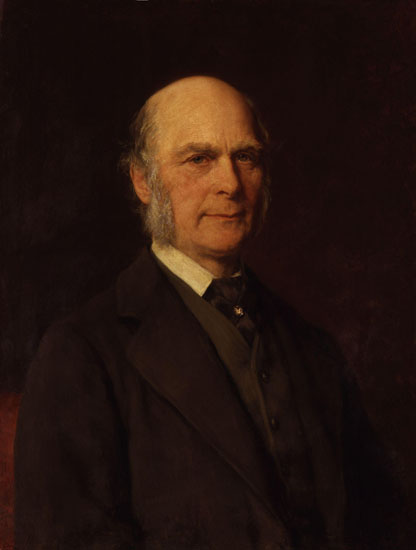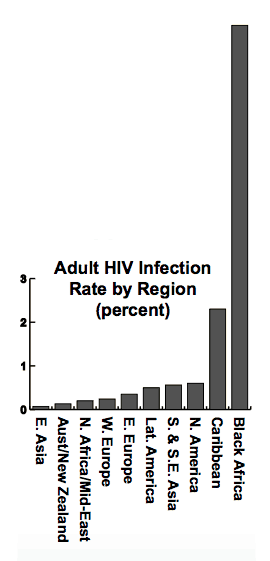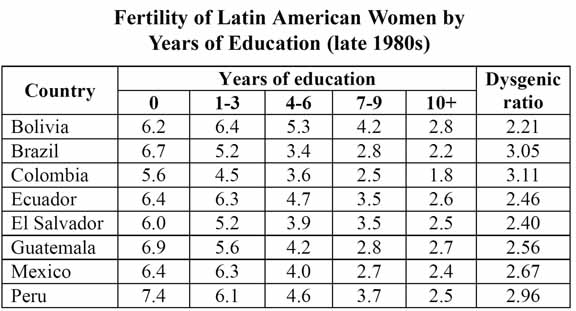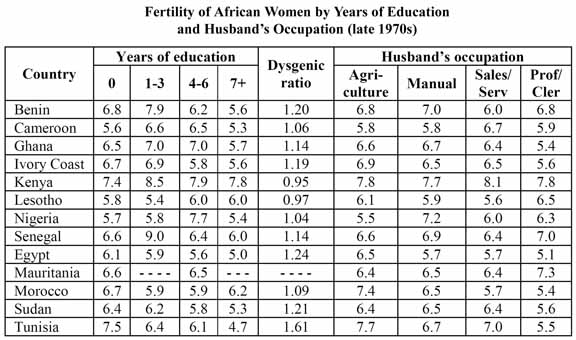The Decline of the West
Thomas Jackson, American Renaissance, October 2011
Richard Lynn, Dysgenics: Genetic Deterioration in Modern Populations, Second Revised Edition, Ulster Institute for Social Research, 2011, 381 pp.
In 1996, Richard Lynn wrote a remarkable book: Dysgenics: Genetic Deterioration in Modern Populations. It was available only in hardcover for the stiff price of $59.95 and its tiny print run quickly sold out. Earlier this year, there was just one second-hand copy available on Amazon.com — for $400.
Fortunately, Prof. Lynn has just released a revised second edition, so this classic is once again obtainable. It is unquestionably the most thorough investigation of whether differential fertility rates are now reversing the achievements of millions of years of evolution.
The assumptions in this book are simple: Human characteristics are heritable. Some are more desirable than others. When people with desirable characteristics have more children than those with undesirable characteristics we evolve. When they do not we degenerate. These principles are taken for granted by plant or animal breeders; it is only when they are applied to humans that they become controversial.
The desire to improve human genetics is called “eugenics,” a word coined by the British scientist and polymath Francis Galton (1822 – 1911) in 1883. “Dysgenics,” a term first used by the British doctor Caleb Saleeby (1878 – 1940) in 1915, means the reverse: genetic deterioration.

Sir Francis Galton
Darwin also worried about genetic decline. In his 1871 book, The Descent of Man, he noted that “the weak members of civilized societies propagate their kind,” adding that “no-one will doubt that this must be highly injurious to the race of man.” By the end of his life, Darwin was gloomy about the future of mankind because people he called “the scum” were reproducing so quickly.Galton was greatly influenced by his half-cousin Charles Darwin (1809 – 1882), whose 1859 The Origin of Species revolutionized biology. Galton immediately grasped the implications of evolution for humans, and was worried that the upper classes, whom he assumed to be genetically superior, were having fewer children than the lower classes. In the past, nature had winnowed out the less fit, but modern societies kept them alive through charity. Galton thought it necessary “to replace natural selection by other processes,” namely, selective breeding. He wrote that “it would be quite practicable to produce a highly gifted race of men by judicious marriages during several consecutive generations.”
The philosopher Herbert Spencer (1820 – 1903), who coined the term “survival of the fittest,” shared Darwin’s pessimism, and opposed social welfare, arguing that “to aid the bad in multiplying is, in effect, the same as maliciously providing for our descendants a multitude of enemies.” These men believed that misguided kindness had put an end to the forces of evolution.
Prof. Lynn explains that evolution works through two effects: greater reproductive success for the fit and higher mortality for the less fit. Almost all pre-industrial societies are examples of the first effect: The strongest and smartest men of the tribe become leaders and monopolize the women. One study of Kalahari Bushmen found that virtually all women had children but only 38 percent of men did.
Polygamy is therefore eugenic. Men who can support and manage many wives are likely to be superior to men who cannot, and their children inherit these superior traits. Prof. Lynn therefore argues that the Catholic Church had a dysgenic effect on the West when it banned polygamy. He wonders why the Roman emperors who adopted Christianity deprived themselves of multiple wives and scores of children, but notes that lower-class men were now better able to find wives. Prof. Lynn points out that the 4th century decision to require celibacy of priests was also dysgenic, since men with the intelligence to become priests were forced to be childless.
An example of the other evolutionary force — higher mortality of the unfit — is the culling effect of diseases. Before Europe had good sewers and clean drinking water, it was the poor, who lived in crowded and dirty conditions, who were most likely to die from childhood diseases and epidemics. The rich, who were presumably genetically superior, lived in healthier conditions and were more likely to survive. If women of all classes practiced natural fertility — that is to say, did not try to limit their childbearing — the results were eugenic because of greater mortality among the unfit.
Birth records in Europe suggest that natural fertility was nearly universal up until about 1880. The only exception was France, where the nobility and high bourgeoisie began limiting births about 80 years earlier. In 1870, the latex condom was invented, and the smartest, wealthiest, and most self-disciplined people started using it first. The number of births in the upper classes plummeted, leading to what Prof. Lynn calls dysgenic fertility, that is to say, higher fertility among the unfit than the fit. The first half of the 20th century was therefore sharply dysgenic, but later in the century, as the middle and lower classes also began to use contraception, their birthrates also declined — but not as much. In all developed countries, fertility is still dysgenic and likely to remain so.
This is not to say that natural selection has completely disappeared. Infant mortality is highest among the least intelligent and least educated; some women are simply not capable of looking after a baby. Likewise, the children of unmarried women die more frequently than those of married women. Prof. Lynn argues that this is because single mothers are more heedless and less capable than women who marry before they have children. This has always been true, but when strictures against bastardy were severe, the eugenic effect was stronger; single mothers often exposed unwanted babies. Prof. Lynn says that until the middle of the 19th century it was common to see dead babies left in gutters and on rubbish heaps.
Prof. Lynn points out that sexually transmitted diseases (STDs) also contribute to natural selection because some result in sterility and AIDS can kill people of reproductive age. There are no data on the average IQs of people who get STDs because no one dares research this, but these diseases are found disproportionately in the lower classes.

Medical advances, on the other hand, are often dysgenic because they mean that people with what used to be fatal defects now live to reproduce. Prof. Lynn cites evidence that over the next 30 years in developed countries, there will be a 26 percent increase in hemophilia and a 120 percent increase in cystic fibrosis. The welfare state is, of course, highly dysgenic. It takes the sting out of reckless procreation, which is most likely to be practiced by the unfit.
Dysgenic fertility differs by sex. It is greater for women than for men, and this is true at both ends of the fitness scale. That is, compared to men, the most able women have even fewer babies and the least able women have even more. The burden of childrearing falls more heavily on women, so at the top end of the fitness scale, many smart, ambitious women put off having children while they establish careers. By the time they decide to have children, they may be infertile or able to have only one or two. At the same time, most women still want to marry men who are smarter and better educated than themselves, and the pool of potential mates becomes very small for the smartest women.
Many men can still count on a wife to look after children while they build their careers, and even if they delay having children they remain fertile much longer than women. Smart, rich, high-status men can attract mates of childbearing age even as they approach old age.
There is a mirror-image effect at the bottom end of the fitness scale. Even the dimmest, least capable women of reproductive age have no trouble finding sex partners. Such women are least likely to use contraception, and therefore have many children, especially in societies with generous welfare. Dim, incapable men, on the other hand, may have a hard time finding partners, and so have few children.
These dysgenic effects are worse for blacks than for whites. Many low-IQ black women have many children, whereas smart, educated black women cannot find black men at their own social level. The average intelligence of blacks is therefore falling faster than that of whites.

Is average IQ actually falling? The first eugenicists had no way of measuring the decline because they did not have IQ tests. Once they became available, scientists hit upon a clever way to determine if fertility was dysgenic: measure the IQs of children and see if the smart ones had fewer siblings than the dim ones. Because siblings have similar IQs, if smart children have few brothers and sisters, it means average IQ is falling. The first tests of this kind were carried out in the 1920s and found a clear, negative correlation between IQ and number of siblings.
Some people have argued that even if smart children have fewer brothers and sisters than dim children, it is not because smart parents are having fewer children, but because parents put more effort into fewer children, thus boosting their IQs.
This is unlikely. First, single children are no smarter than children with just one sibling, despite the fact that they presumably get twice as much parental attention. The IQ differences are found between one- and two-child families and four- and five-child families. At the same time, the negative correlation between IQ and number of siblings is not found in families of adopted children. Finally, there are some underdeveloped countries that do not yet have dysgenic fertility, and family size has no correlation with intelligence.
Another way to check for dysgenic fertility is to test a representative sample of adults for intelligence and see whether the smart ones have fewer children. This method also suggests decline. Prof. Lynn cites many attempts to calculate the rate of decline in Western societies, with figures running from 3 IQ points per generation to 0.58 points per generation. He concludes that estimates in the lower range are more accurate.
Prof. Lynn points out that the gene pool deteriorates even if there is perfectly even fertility — neither eugenic nor dysgenic. Imagine a population in which every child reaches maturity and has exactly two children each. This would ensure genetic stability — but for mutations. The human body is already so well designed that mutations are almost always harmful, and greater exposure to chemicals and radiation makes them more common. Thus, a certain amount of eugenic fertility is necessary just to stay even.
Intelligence is rising
Despite all the reasons to believe that the average intelligence is falling in developed societies, it has actually been rising for the last half century or so. This rise, known as the Flynn Effect (though it should perhaps be known as the Lynn-Flynn Effect because Prof. Lynn wrote about this rise even earlier than did Prof. James R. Flynn for whom it is named), was discovered by using IQ tests standardized for different time periods. Tests are regularly “renormed,” that is, they are given to a large, representative sample and the questions adjusted so that the average is 100.

It was a surprise to many psychologists to learn that people in developed countries do better on tests normed for 1950, say, than on tests normed for 1980. The older tests are easier, which means IQ is rising — as much as two to three points per decade since the 1940s.
Various theories have been proposed to explain this. One was that children have become “test wise,” that is, they have simply got better at taking tests even if they are actually less intelligent. This is unlikely, though, because two- to six-year-olds, who have not had time to become “test wise,” get higher scores, too. Another theory was that children were maturing more rapidly, showing an IQ gain over children of earlier decades, but that their adult IQ scores were no higher. Wrong again. Adults get higher scores, too.
Prof. Lynn believes that improved nutrition accounts for the rise, and that this masks the genetic deterioration that must be taking place. Genetic intelligence has been declining, but phenotypic intelligence — its expression in human beings — has been rising. Prof. Lynn likens this to planting worse and worse seeds but getting ever-larger harvests by pouring on more and more fertilizer.
Nutrition has diminishing returns, however, and can raise IQ by only so much; Prof. Lynn points out that Flynn-Effect gains have stopped in most developed countries. Denmark, for example, which tests all young men for military conscription, is typical: It found that average IQ peaked in 1998, with a gentle decline since then. Prof. Lynn believes further declines are inevitable as the effects of dysgenic fertility begin to bite. Poor countries, on the other hand, can look forward to Flynn-Effect increases as their diets improve.
Other traits
The early eugenicists recognized that high achievement requires not just intelligence but also persistence and self-discipline, which they called “character.” Again, they had no tools for measuring character but were convinced that the upper classes had more of it than the lower classes, and that dysgenic fertility meant deterioration in character.

Credit Image: Lou Jones / ZUMAPRESS.com
Today, there are various ways to measure what psychologists call “conscientiousness.” One is by using pencil-and-paper tests, which give surprisingly consistent and reliable results. Conscientiousness is, indeed, correlated with social class and is highly heritable, just like intelligence. Twin studies and adoption studies of the kind that measure the heritability of intelligence suggest that about two-thirds of the variation in conscientiousness is due to genes, and one-third to environment. For example, one adoption study found that the level of psychopathic personality — considered the opposite of conscientiousness — of the biological mother was a three-times better predictor of psychopathic personality in a child than was the level of psychopathy of the adopting mother.
Smoking, alcoholism, obesity, sexually transmitted disease, and illegitimate childbearing are also considered signs of low conscientiousness because people with strong wills usually avoid these things. Not surprisingly, they are found more often in the lower and working classes. In like manner, it is typical to find that working-class children prefer a small reward now rather than a large reward later, whereas upper-class children have the discipline to forego a small reward now for a bigger one later.
The famous Terman Study of the Gifted that identified 1,400 highly intelligent young Californians in 1921 and has tracked them ever since, found that those who did not achieve at high levels lacked conscientiousness. As Terman himself noted, “intellect and achievement are far from perfectly correlated.”
Criminality is another example of “bad character” and is likewise heritable. In one study, researchers found 41 female criminals who had given 52 babies up for adoption. They also found another sample of 52 adopted children from mothers of non-criminal but otherwise comparable women. All the children were adopted by non-criminal families. Seventeen of the children of criminals ended up with criminal records whereas none of the other children did. Prof. Lynn examines several similar studies and concludes that criminality is .68 heritable for men and .58 for women.
Eugenicists, of course, are curious to know whether criminals have more children than non-criminals, but Prof. Lynn was surprised to find that no one has ever researched this question. From the 1950s to the 1990s, when crime rates were rising quickly, this would have been an obvious area of study, but political considerations no doubt ruled it out. Prof. Lynn did find that criminals have more siblings than non-criminals, and has little doubt that crime-related genes have been spreading for many decades. Nor has there been a Flynn effect to counter genetic decline; during the 20th century crime rates soared in the developed world, just as eugenicists would have predicted.

Egalitarians are repelled by the thought, but social classes are genetically stratified. Egalitarians would rather believe that if upper-class children do better in life, it is because they got unfair advantages from their upper-class parents. However, as Prof. Lynn points out, one third of all children end up in a different social class from that of their parents — either up or down. A child’s IQ is a better predictor of where he will end up than is the social class of his parents.
Adoption studies support the importance of IQ: There is hardly any correlation between an adopted child’s eventual social level and that of his adoptive parents. There is a strong correlation with that of his biological parents.
Education has a high correlation with intelligence and social class, and Prof. Lynn offers eye-opening data on education and unplanned births. In 1998, American mothers who were high school dropouts admitted that no fewer than 58 percent of their births had been unplanned. The figures for high school graduates was 46 percent; for mothers with some college 39 percent; for college graduates 27 percent. It is likely always to be the case that the least educated will practice contraception least competently.
As the table below shows, Latin America has sharply dysgenic fertility. The “dysgenic ratio” is calculated by dividing the fertility of the group with the least education by the fertility of the group with the most. According to polls, Latin American mothers with little education are not having more children because they want them. Like their North American counterparts, they are having them by accident.

As the next table shows, some of the better-off African countries have reached the dysgenic-fertility stage, but most have not. In the poorest countries not even the upper classes use contraception, so fertility is not dysgenic. At least this was still the case in the late 1970s.

Prof. Lynn notes that immigration affects the genetic quality of a population. Given the mix of low-IQ people coming to the United States, he predicts a 4.4 point decline in average IQ between 2000 and 2050. He expects gentler declines in Canada and New Zealand because they receive relatively more high-IQ Chinese immigrants.
Needless to say, world fertility is sharply dysgenic because North Asians and whites are not even replacing themselves while the populations of Africa and South Asia are growing quickly. Prof. Lynn predicts that between 2000 and 2050 there should be a world-wide decline of 1.29 IQ points per generation for this reason alone.
It is, of course, taboo to notice or care about any of this, but this was not always so. Prof. Lynn points out that eugenics was broadly supported up through the first half of the 20th century. Perhaps its high point was a 1963 meeting attended by three Nobel laureates in genetics, Francis Crick, Hermann Muller, and Joshua Lederberg, all of whom were staunch eugenicists. Crick, for example, said that it was bad for society to let everyone have children, and that only people who met certain criteria should be licensed to reproduce.

The subsequent decline of eugenics was very quick. When the British scientist Steven Jones was appointed in 1990 to head what was still known as the Galton Laboratory at University College in London (and absorbed by the biology department in 1996), he said he considered Galton “a fascist swine.”
Today, eugenics is held in universal disrepute but many objections to it are silly. James Neel of the University of Michigan claims that “any attempt at varying the number of children according to parental attributes requires massive value judgments which cannot be supported on social or scientific grounds.”
Massive value judgments? Educational curricula and the criminal codes are both based on value judgments. Nor do people have much trouble naming traits they consider desirable — unless they are academics. Another anti-eugenicist, David Smith of the University of South Carolina, asks: “Is mental retardation always a disease to be prevented, or is it a human condition worthy of being valued?”
One British scholar, Donald McKay, says there should be no attempt to raise the general level of intelligence because that would make criminals smarter. He doesn’t seem to realize that the police would be smarter too, and that if criminals were smarter they would be more likely to find proper jobs.
Of course, virtually everyone understands that genetic laws apply to human beings, and intelligent people practice eugenics to the extent they can. Most obviously, they choose their spouses carefully. Many pregnant women undergo amniocentesis, which gives an indication of the genotype of the fetus, and has only one purpose: to make it possible to abort defectives. Known carriers of serious genetic illnesses may also seek “genetic counseling” before they have children.
People looking for egg or sperm donors are often very particular about what they want. Most supply agencies offer detailed profiles of donors that often include SAT, ACT, or IQ scores. Some infertile couples solicit especially outstanding donors through advertisements in Ivy League college newspapers.
Eugenics and dysgenics are yet another self-destructive taboo, and with this magisterial treatment, Prof. Lynn has again given us a splendid contribution to our understanding of ourselves.
[Editor’s Note: This article first appeared in the October 2011 issue of American Renaissance.]















